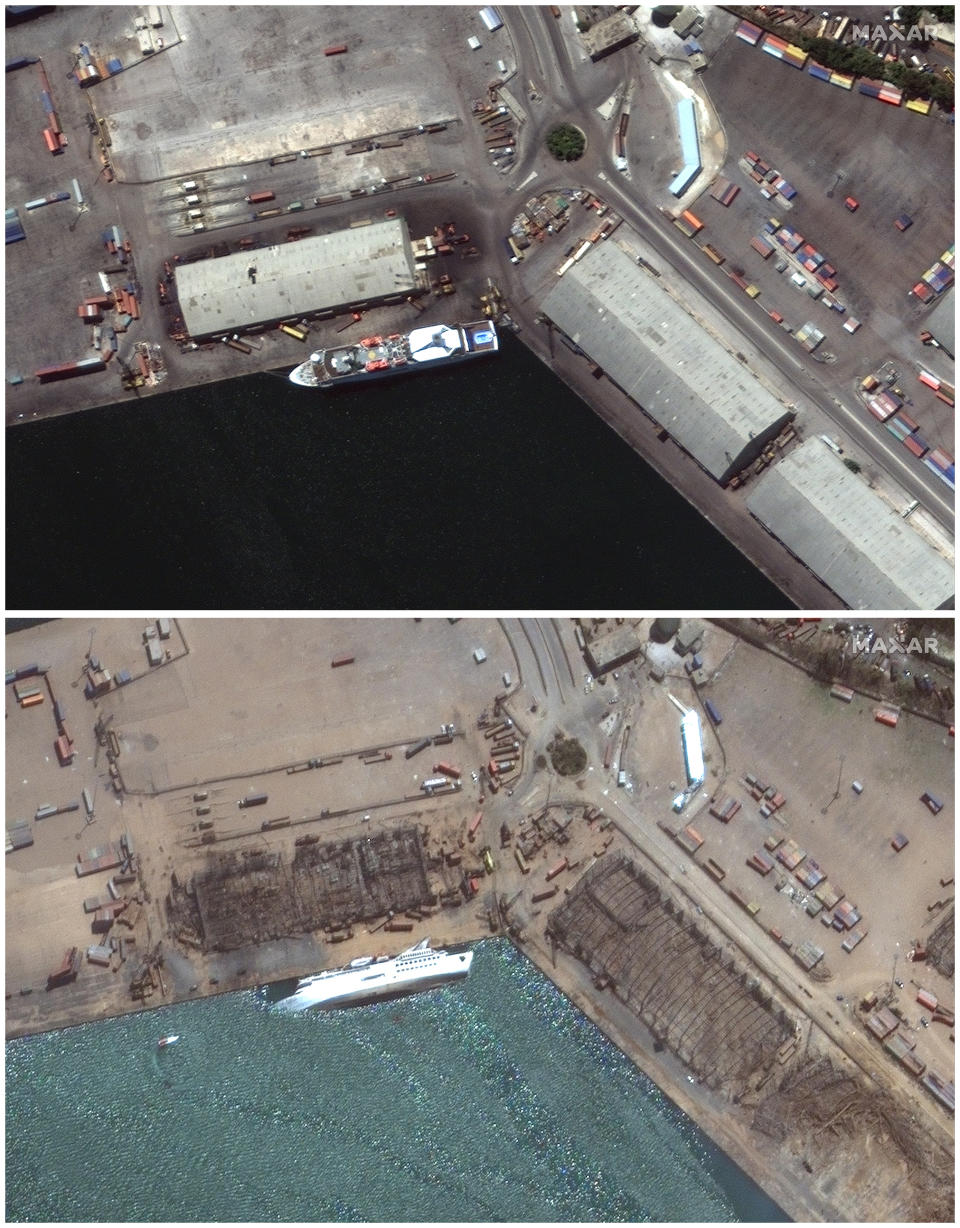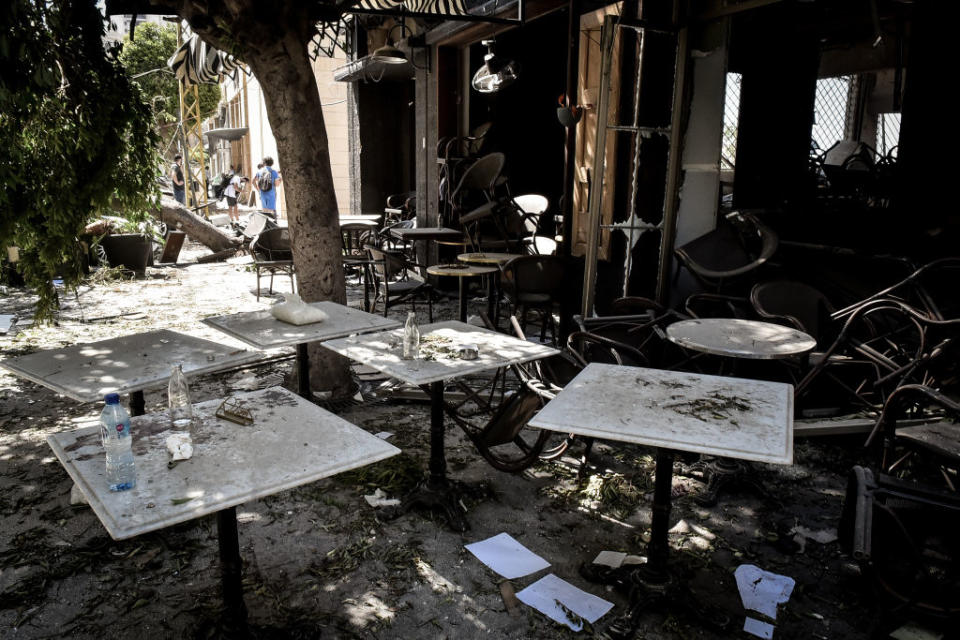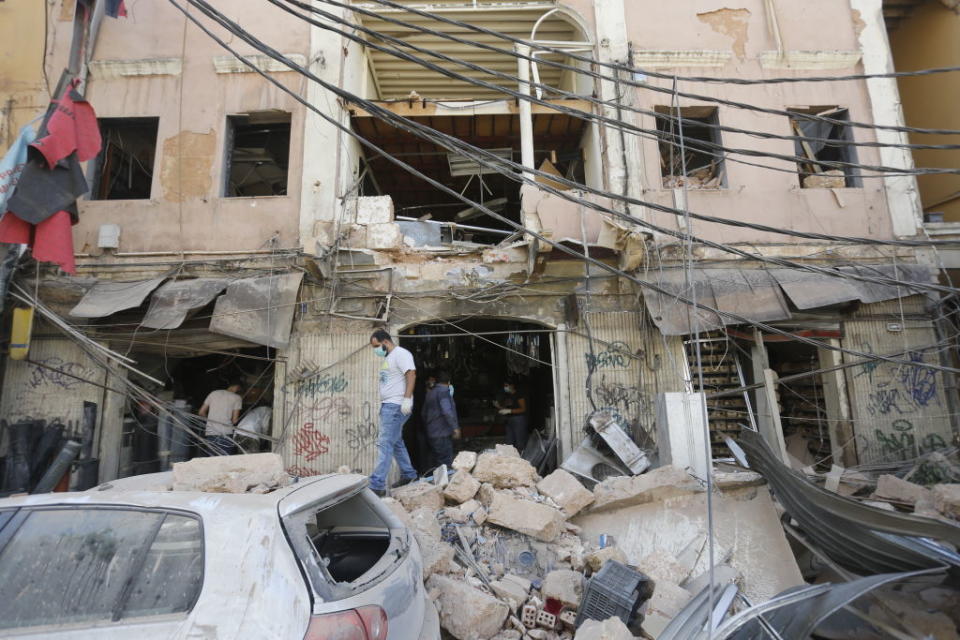Before and after photos show 'apocalyptic' aftermath of Beirut explosion
Before and after photos show the devastating aftermath of the Beirut explosion, which has claimed the lives of at least 135 people with more than 5,000 injured.
One set of photos taken from space shows the extent of the damage done to the port area of Lebanon's capital with a huge crater left by the blast.
A second set shows a ship docked in the port in one photo surrounded by buildings, and an after photo depicts the vessel overturned and the buildings levelled.
Initial investigations into the massive Beirut port blast indicate years of inaction and negligence over the storage of highly-explosive material caused the devastating explosion.

The prime minister and presidency have said 2,750 tonnes of ammonium nitrate, used in fertilisers and bombs, had been stored for six years at the port without safety measures.
Anger from residents in the city has been directed at the head of customs and the port authorities in the Lebanon capital, as well as the ruling elite of the country which is teetering on economic collapse.
An unnamed source close the investigation described “negligence” as the cause of the blast, saying the issue on storing the material safely had come before several committees and judges, and "nothing was done".
A fire began at port warehouse 9 on Tuesday (local time) and spread to warehouse 12, where the ammonium nitrate was stored. The result was the most powerful explosion ever suffered by Beirut, a city still baring the scars of civil war three decades ago.
Another anonymous source close to a port employee told Reuters a team that inspected the material six months ago warned it could "blow up all of Beirut" if it was not removed.

The head of Beirut port and the head of customs both said on Wednesday several letters were sent to the judiciary asking for the dangerous material be removed, but no action was taken.
Port General Manager Hassan Koraytem told local media station OTV the material had been put in a warehouse on a court order, adding they knew then the material was dangerous but "not to this degree".
"We requested that it be re-exported but that did not happen. We leave it to the experts and those concerned to determine why," Badri Daher, director general of Lebanese Customs, told broadcaster LBCI.
Former prime minister Saad al-Hariri, whose father and also a former premier was killed in a large truck bomb attack in 2015 in the capital, called for a foreign role in investigating the blast that "once again killed the heart of Beirut".
"We ask the government... for a transparent judicial and security investigation without compromise, denial or circumventing the truth," he said in a statement.

Anger and compassion rises from the rubble
Lizzie Porter, a senior reporter for Iraq Oil Report, described an “apocalyptic” scene of as she and others surveyed the “total destruction of buildings” earlier.
Speaking to ABC Radio on Thursday morning (AEST), she spoke of the total carnage left behind and the renewed anger the explosion had fuelled among an already precarious population.
“People are shocked, angry and traumatised by what’s going on,” she said.
“In among the trauma and the shock, this for them is another example of the lack of government and corruption.
Mar Mikhaïl district in #Beirut today. This was before yesterday’s explosion a hub of bars, cafes & shops. It’s now damaged & destroyed. Blast has changed the shape of the city. Today I didn’t recognise places where I’d walked 100s of times before. #Lebanon #انفجار_المرفأ pic.twitter.com/2sfaJFNw2Z
— Lizzie Porterلِيزي بورتر (@lcmporter) August 5, 2020
“The material is believed to have come in on a ship... it was supposed to be auctioned off or disposed of carefully but that never happened.”
The Governor of Beirut estimates 300,000 people have been left homeless by the blast which has damaged buildings in nearly half the city, with has an estimated population of 2.4 million in 2020.
Elegant stone buildings, fashionable shopping districts and long stretches of the famed seaside promenade were reduced to rubble within seconds of the blast while countless homes and apartment blocks have also been rendered unliveable.


Porter herself is staying with a friend after her apartment was badly damaged, but said locals were banding together and those with homes still standing were opening them up to others.
On social media the hashtag #OurHomesAreOpen, in Arabic and English, has spread with people offering their home for people displaced by the blast.
The disaster, which rattled windows about 160km away, has united the city. But for many, they’re united in anger and despair.
"They are so irresponsible that they ended up destroying Beirut," retired school teacher Sana told the Associated Press.
She was preparing to leave her heavily damaged apartment in Mar Mikhael, unsure of what the future would hold.
"I worked for 40 years to make this home and they destroyed it for me in less than a minute,” Sana said.
with Reuters
Do you have a story tip? Email: newsroomau@yahoonews.com.
You can also follow us on Facebook, Instagram and Twitter and download the Yahoo News app from the App Store or Google Play.

 Yahoo Lifestyle
Yahoo Lifestyle 

